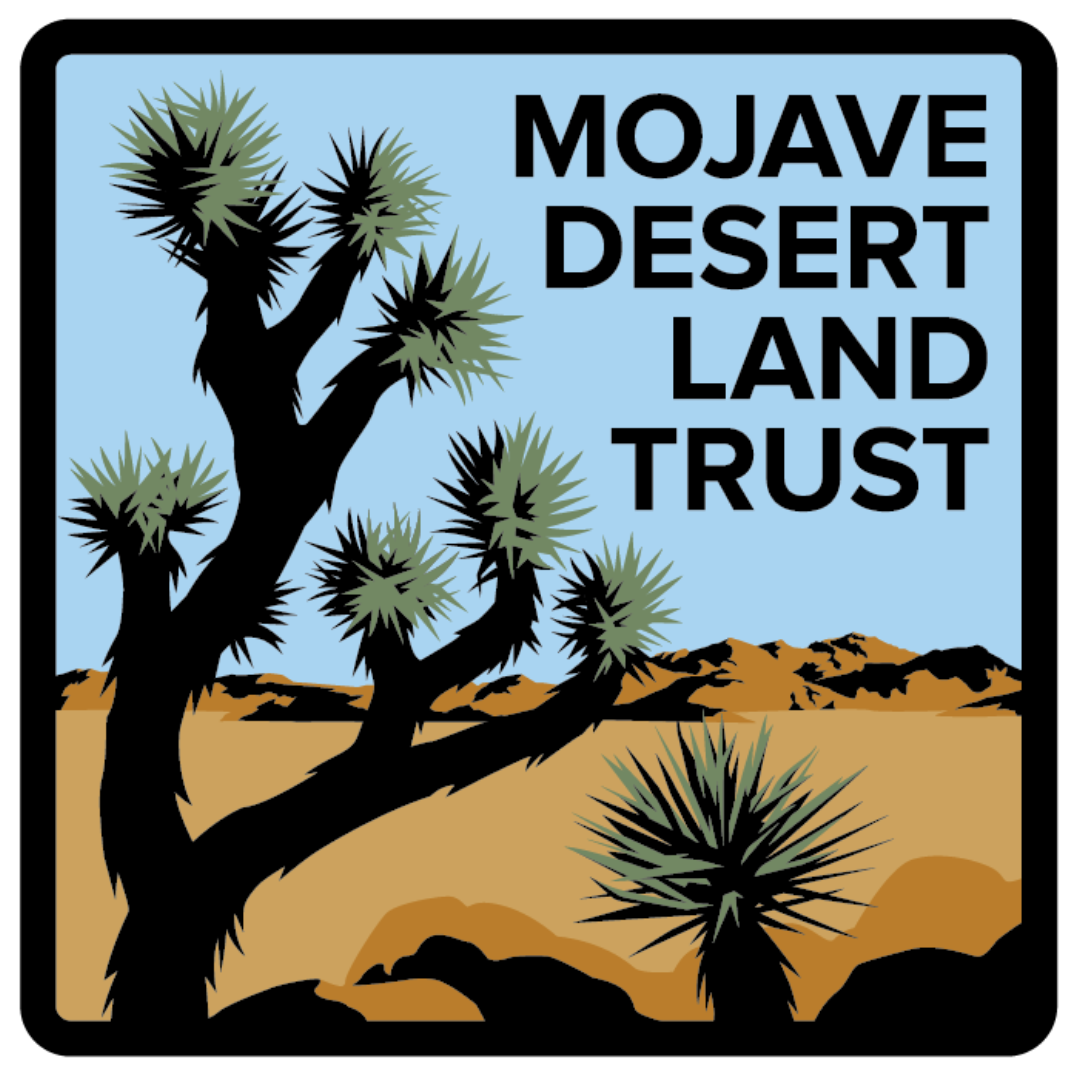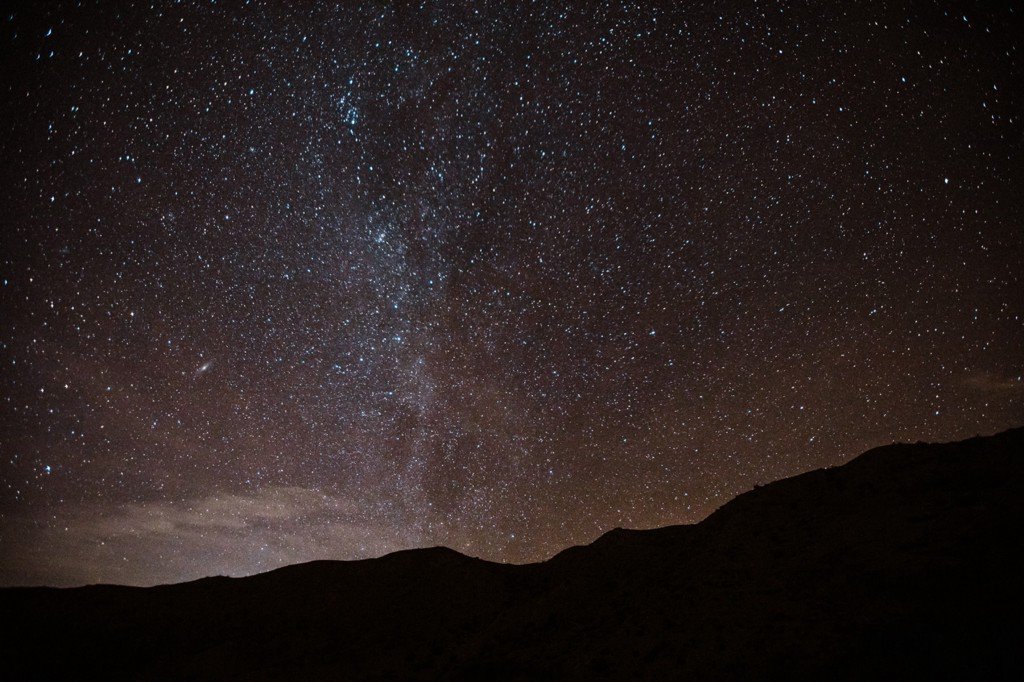New data pinpoints dark skies above Mojave Trails National Monument
Interns with the Women In Science Discovering Our Mojave program spent a year studying night sky quality. Their findings provide a new baseline of data about the Mojave Desert.
The Milky Way over Mojave Trails National Monument. Photo: Global Eyes Media
By Mary Cook-Rhyne, Education Coordinator, Mojave Desert Land Trust
Between September 2020 and October 2021, a total of six interns participated in the WISDOM (Women In Science Discovering Our Mojave) program to study the night sky quality in Mojave Trails National Monument. This baseline study was intended to help the Bureau of Land Management in its efforts to seek International Dark Sky Sanctuary recognition for the monument. As part of the International Dark Sky Association’s qualification process, night sky brightness measurements must be equal to or darker than 21.5 magnitudes per square arc second. A meter reading of 21.00 would indicate a very dark site, while a reading of 16.00 would indicate a light polluted sky. Using a Sky Quality Meter and citizen science applications, the WISDOM interns measured brightness at 16 locations within the monument and contributed the data to the Globe at Night citizen science project about the number of stars visible to the naked eye.
The findings show that Mojave Trails National Monument can be placed in consideration as a Dark Sky Sanctuary in almost all locations. Flora and fauna rely on the day and night cycle to govern their behaviors. Light pollution, also known as sky glow, has significantly increased over the last decades, directly causing changes to environmental adaptions for many organisms. Artificial lighting affects species’ migration patterns, predator-prey relationships, and the circadian rhythms of most animals, including humans (International Dark Sky Association 2021). Mojave Trails National Monument spans 1.6 million acres between Barstow and Needles, California. Shaped like a big “U”, the monument borders Mojave National Preserve and reaches as far south as Joshua Tree National Park. It is administered by the Bureau of Land Management and is part of the National Conservation Lands system.
Afton Canyon in Mojave Trails National Monument. Photo: Global Eyes Media
The monument contains natural features like rugged mountains, sand dunes, wilderness areas, the Mojave River, beautiful open vistas, and culturally significant prehistoric and historic archaeological sites. The monument is an important destination for astronomy clubs and stargazers from the surrounding regions. Additionally, it is a vital ecological wildlife corridor that connects wilderness areas. These tracts of land link open spaces to others, allowing animals and plants to migrate from one area to another. It is a refuge for bighorn sheep, desert tortoises, fringe-toed lizards, bats, and migratory birds. Between September 2020 and October 2021, a total of six interns participated in the WISDOM program to study the night sky quality within Mojave Trails National Monument. WISDOM aims to help engage women in STEM, to increase understanding of not only environmental science and land management issues in the Mojave Desert, but to also provide women with opportunities to conduct that research. Their research will help the Bureau of Land Management in its effort to work toward International Dark Sky support for the monument. To qualify as a Dark Sky Sanctuary the area must be public or private land, accessible to the public in part or whole, and be legally protected for scientific, natural, educational, cultural, heritage and/or public enjoyment purposes. The site must provide an exceptional dark sky resource where the night sky brightness is routinely equal to or darker than 21.5 magnitudes per square arc second. Sixteen locations across the monument were visited to record data. WISDOM interns measured eight spots once a month first in the western portion, then another eight locations in the eastern portion.
Methods
An International Dark Sky Association-recommended Sky Quality Meter (SQM) was used to record sky quality data. Hanel, et. al. (2018) discusses using a handheld SQM as a viable option for long-term studies of night sky brightness. During the year-long study, interns used a Unihedron SQM-L device, Model: 2.19, to measure night quality. Zenith, temperature, weather, and visibility are also recorded. GPS points were taken at each of the locations. Additionally, photos were taken of the night sky using a Canon DSLR camera. Field nights generally consisted of a 6.5-hour work period, followed by an office day to synthesize data. The Loss of the Night citizen science app was also used during the data collection sessions. It was created to accompany the Globe at Night project, which gathers information from community scientists throughout the world about the visibility of the night sky. The app features an easy way to learn constellations and the positions of planets in the night sky.
More than 1,000 stars are visible at every location surveyed in the monument according to the Loss of the Night app.The Dark Sky Meter citizen science application was also used for data gathering. The app works in two steps: the first is to cover the phone camera then press the dark button. After that, aim the camera to the point in the sky directly above and press sky. The greater the difference between these two shots, the more reliable the data. This application works to compile a global, high-resolution map of dark places and areas where light pollution has become problematic. The app also charts weather conditions and cloud cover so that readings are taken at optimal times.
The darkest spot in the monument, on average, is at Camp Iron Mountain, a World War II Desert Training Center Camp used to prepare troops to fight in the North African campaign.The brightest spot in the monument is located in the Sheephole Valley Wilderness Area, west of Amboy Road and overlooking the American Chloride Mine, therefore more light pollution was expected. Overall, only one location, Bagdad, measured lower than 21 magnitudes per square arc second, missing that mark by just 0.04 mags.The eastern half of Mojave Trails National Monument measures darker than the western portion. However, the western portion is also more accessible to visitors. Afton Canyon Natural Area is home to the only developed campground in the entire monument and therefore, can be more easily visited. Measuring at 21.1, Afton Canyon still offers exceptional night sky quality.
Conclusion
Mojave Trails National Monument can be placed in consideration as a Dark Sky Sanctuary in almost all locations, as the average magnitudes per square arc second is over 21.5. Overall, the Milky Way, over 1,000 stars, shooting stars, and constellations can be seen throughout the monument.Although few cities and towns are located near the monument, sky glow is encroaching on the night sky quality in some locations. We must also consider weather at some locations. As an example, the 2020 Dome Fire in Mojave National Preserve caused glare to be accentuated during one of the WISDOM field nights.A Dark Sky Sanctuary designation would mean protection and conservation of the area’s dark night skies, while also allowing for education about their importance for desert flora and fauna. We will be able to empower others to become conservationists and citizen scientists of the land and sky.Light pollution is one of the most preventable and readily fixable forms of pollution. As the Bureau of Land Management moves toward developing management plans for Mojave Trails National Monument, they can also take into account ways to conserve the night sky, for now and generations to come. Mojave Desert Land Trust press release about the findings
References and further reading
Bouroussis, Constantinos A., Frangiskos V. Topalis (2018). The effect of the spectral response of measurement instruments in the assessment of night sky brightness. Journal of Quantitative Spectroscopy and Radiative Transfer, 216: 56–69.Chepesiuk, Ron (2009). Missing the Dark: Health Effects of Light Pollution. Environmental Health Perspectives 117:1 CID: https://doi.org/10.1289/ehp.117-a20.
Falchi, Fabio, Pierantonio Cinzano, Christopher D. Elvidge, David M. Keith, Abraham Haim (2011). Limiting the impact of light pollution on human health, environment and stellar visibility. Journal of Environmental Management, 92(10), 2714–2722.
Hänel, Andreas, Thomas Posch, Salvador J. Ribas, Martin Aubé, Dan Duriscoe, Andreas Jechow, Zoltán Kollath, Dorien E. Lolkema, Chadwick Moore, Norbert Schmidt, Henk Spoelstra, Günther Wuchterl, Christopher C.M. Kyba (2018). Measuring night sky brightness: methods and challenges. Journal of Quantitative Spectroscopy and Radiative Transfer, 205, 278–290.
International Dark-Sky Association (2021). Light Pollution Effects on Wildlife and Ecosystems. https://www.darksky.org/light-pollution/wildlife/, Accessed November 1, 2021.
Walker, Merle F., (1977). The Effects of Urban Lighting on the Brightness of the Night Sky. The Astronomical Society of the Pacific, 89:405–409.
Get involved
For the Night Sky project, we are participating in the Globe at Night and Loss of the Night citizen science programs. Why not join in? Our collective information can help our global community study light pollution around the world.
Women in Science Discovering Our Mojave (WISDOM) is an MDLT internship program in collaboration the Bureau of Land Management that seeks to help engage women from underserved communities studying Science, Technology, Engineering, and Math (STEM). We would like to thank our donors and partners in making this WISDOM project possible: Southern California Edison, Conservation Lands Foundation and the Bureau of Land Management.




